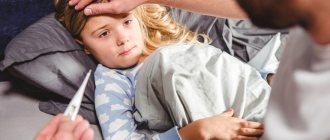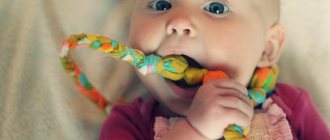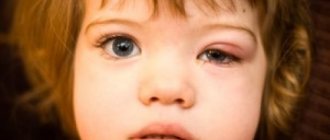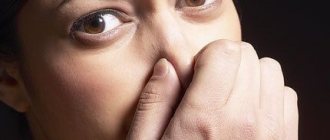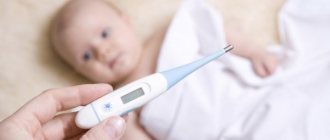The most common problem is when a child has a high fever. As often happens in families with small children. This is the main problem with which mothers come to see a pediatrician. It's clear. After all, a fever in a child causes panic in many parents. Many disturbing questions flash through my head. Most often people are interested in the question of what caused the temperature to rise, how to behave when it rises in a child, what means to bring down the temperature, whether it is worth calling an ambulance or whether you can cope on your own. These questions arise especially acutely when there is a very small child in the family. Therefore, all parents need to know the basic rules for lowering fever, what symptoms of a disease are indicated by an increase in temperature, and when emergency medical intervention is required.
Were you able to lower your temperature on your own? Wonderful! However, this is not yet a solution to the problem. You should definitely consult a specialist. After all, the temperature could rise due to a rather serious illness.
Dr. Komarovsky advises parents to definitely contact their pediatrician for advice if their baby has a high temperature for no obvious reason.
In fact, an increase in temperature is the norm, and in some cases even a necessary reaction of the body to an injury or illness. Thus, the body’s desire for self-healing is manifested. There is resistance to the invasion of viruses, bacteria and other substances that harm the body. Therefore, Komarovsky insists that the use of antipyretic drugs is not always justified. Although there are situations in which an increase in temperature poses a threat to life, and a decrease in temperature is an urgent need.
According to the opinion expressed by Dr. Komarovsky, in the summer the temperature rises due to overheating, while in other cases when there is no heat, viral infections may be the cause. If the child has a high fever, the child should receive proper care. So, if the temperature has risen due to viruses, Komarovsky advises creating all the conditions for the child so that his body can cope with this virus on its own. Firstly, you should not overload your child’s body with food. After all, the liver is the main organ of the digestive and immune system. Secondly, the child needs to be given the right amount of fluid to combat fever. Thirdly, the room where the child is located must be perfectly clean, cool and humid air.
Increased body temperature: causes
Humans are warm-blooded creatures. If the body temperature rises, then it is quite possible that he is very overheated, there is a viral infection in his body, or an inflammatory process is occurring. But it should be understood that fever (fever) or high temperature is not a disease, but a symptom indicating the presence of a health problem. Komarovsky considers an increase in temperature not a symptom, but a protective reaction of the body, which is very useful. Therefore, there is no need to fight high temperatures. Otherwise, the recovery process will take even longer, because artificially lowering the temperature does not allow the child’s body to fight the infection on its own.
Komarovsky: a child’s temperature
The well-known pediatrician Evgeniy Olegovich Komarovsky speaks of the existence of two stages of reducing temperature: through the use of medications and without medications. Komarovsky advises parents to bring down the temperature using ibuprofen and paracetamol. If the child's temperature increases at night, light candles.
Komarovsky agrees with the majority of sensible colleagues who claim that when the general body temperature rises during illness, natural interferon is more actively produced. By 2-3 days, its quantity is produced sufficiently to effectively fight any infectious agent. This actually explains the decline of any acute respiratory viral infection after 3-4 days from the onset of the disease.
Komarovsky how to bring down the temperature
Expert + Educator + Teacher
30 subscribers
A child's temperature gives parents a lot of anxiety. They try to alleviate the baby’s condition as quickly as possible, using available means to reduce the thermometer readings. Dr. Komarovsky advises following rules that allow you to determine when to lower a child’s temperature and how to do it correctly.
According to the famous doctor Komarovsky, parents should not immediately grab antipyretic medications. The fever should be brought down only if it reaches critical levels (39 degrees and above). The exception is children predisposed to febrile convulsions or babies who do not tolerate increased body temperature.
Contrary to popular belief, fever does have some benefits for the body. High thermometer readings are a response to inflammation. By raising the temperature, the child’s body actively fights viruses and microbes. The production of a natural health protector, interferon, begins.
Komarovsky is of the opinion that the disease, in which the temperature was actively reduced, will last longer. By lowering the thermometer readings, parents alleviate the condition, but relieve the body of natural defenses and the subsequent development of immunity.
If a child develops a fever, Komarovsky suggests that parents adhere to the following recommendations:
- Give your child more to drink. Boiled water, tea, unsweetened compote will do. Drinking frequently helps avoid dehydration. Viruses that cause inflammation are also removed from the body along with the fluid.
- Do not use alcohol or vinegar rubs. Doctors consider them harmful to the child's body. Toxic fumes can penetrate inside, further worsening the baby's condition.
- Provide cool air in the room. The optimal temperature is +16 -+18 degrees. This is a good physiological way to reduce a child's temperature. In this case, the baby’s clothes should be quite warm to prevent hypothermia.
- Ventilate the room periodically. Fresh air makes breathing easier and reduces the concentration of pathogenic microbes.
If necessary, give your baby an antipyretic drug, Komarovsky recommends using paracetamol-based medications. They have proven themselves as a means of reducing fever during viral infections. It is convenient for infants to use paracetamol in the form of suppositories; syrup is suitable for older children.
If a child’s fever lasts for more than three days, it is accompanied by cold symptoms: cough, runny nose, Dr. Komarovsky advises to consult a doctor to make a diagnosis and prescribe the correct treatment.
How to reduce a child’s temperature: the opinion of Dr. Komarovsky
Children get sick at any age. The temperature rising to 37.5°C does not cause much panic. But what to do if the thermometer is already 39°C? What to do when the thermometer reaches the mark
38°C, but there are no other signs of illness? The answers are given by Dr. Komarovsky, a pediatrician with 30 years of experience, whose opinion is carefully listened to by mothers of children of any age.
According to the doctor, a temperature of 39°C is considered critical and parents should be extremely attentive to the baby’s well-being. Further increase in heat can cause serious harm to the child's body.
“It is unacceptable to limit yourself to self-medication - a high temperature is always a serious reason to call a doctor”
But if there are signs of an infectious disease, then how to bring down a child’s temperature of 39? Komarovsky believes that it is possible to help a child both without medications and with their help. However, there are a number of cases when medications are given without delay:
- The child does not tolerate heat well
- Having difficulty breathing
- There is vomiting or diarrhea
- Once the child already had convulsions due to fever
- There are serious diseases of the nervous system, for example, cerebral palsy or epilepsy
- Temperature rose above 39°C
If the baby feels normal - he does not have delirium, inappropriate behavior, or difficulty breathing, then you can wait to take medications. The main thing is to create special conditions that will help the baby cope with the fever. To do this you need:
Cool air and plenty of fluids are the main allies in the fight against high fever.
Cooling occurs through breathing and sweating. Tea with raspberries, honey or linden blossom is given only after the child drinks more than a liter of regular compote. Otherwise, the baby will have nothing to sweat with and the temperature will rise even more.
“Note to moms! The use of lotions with vodka and vinegar is strictly prohibited - this poisons the child’s body.”
Rubbing with cold water is also not beneficial. They provoke vasospasm. The skin cools down, and the internal organs, on the contrary, overheat even more. If the child’s condition worsens, then it is necessary to move on to the next stage - taking medications.
According to Komarovsky, parents can only give their children paracetamol or ibuprofen in the dosages prescribed in the instructions.
At high temperatures, suppositories do not have the desired effect, but liquid products are absorbed quickly. However, there are times when even syrup cannot cope with intense heat due to spasm of the mucous vessels. The only way out is an injection of an antipyretic drug, which will be given by a doctor.
“Remember! You should not give your child aspirin or analgin - these medications harm the liver and blood-forming organs."
Paracetamol is given at intervals of 4 hours, ibuprofen - 6 hours, but no more than 4 times a day. Medicines are compatible with each other. When paracetamol does not work, you can give your child ibuprofen 40 minutes after paracetamol. If the temperature does not subside within 30-40 minutes after taking antipyretics, you should call a doctor.
As Dr. Komarovsky’s practice shows, a high temperature in a child without symptoms of an infectious disease causes even more bewilderment. Causes of high fever may include:
- Baby overheating
- Growing teeth
- Roseola is a disease caused by a type of herpes virus. In this case, after 3 days of high fever, the child will develop a small rash. No special treatment is provided
- Stress
- Urinary tract infection
If your temperature rises and there are no symptoms, you should definitely see a doctor. Perhaps the doctor will see what is hidden from parental eyes. Perhaps it will simply confirm guesses, for example, about growing teeth.
If the doctor throws up his hands and does not find any visible signs of the disease, then Komarovsky suggests waiting 3-5 days and observing the child. After this period, it is necessary to take blood and urine tests to exclude hidden inflammatory processes.
Summing up
Komarovsky considers a high temperature with signs of an infectious disease or a child with a temperature of 38 without symptoms to be a good reason to immediately call a doctor at home. Parents should help the baby cope with the fever - drinking plenty of fluids, cool air in the room and, if necessary, taking antipyretics will help do this. Analgin, aspirin, vodka, vinegar and cold compresses should be excluded from first aid remedies.
Children tolerate temperatures above 39°C quite hard. In addition, such a temperature is already considered dangerous, especially for those children who suffer from diseases of the cardiovascular system and other chronic pathologies. In addition, some children have individual intolerance to high temperatures, so each parent should know how to act correctly in such situations, how and when to reduce high levels. Modern medicine has somewhat changed the tactics of treating high fever, as well as, in principle, its attitude towards elevated thermometer readings. What to do if a child’s temperature is 39, how to bring it down Komarovsky - a famous pediatrician is ready to share his advice.
High temperature is a normal reaction of the body, the action of which is aimed at destroying foreign agents in the form of viruses, bacteria and infections. An elevated thermometer reading is not a reason for parents to panic or become hysterical. This is a signal that right now they should do the right thing, and not try to bring it down by any means by any possible means.
The first thing that some parents do, who do not hear or do not want to hear doctors, is to use the rubbing procedure with vinegar or vodka. Doctor Komarovsky is simply shouting: “People! You can’t even imagine how many people paid with their lives for such rubbing!” Therefore, never use vinegar or vodka for rubbing with the purpose that they will help you lower body temperature and alleviate the patient’s condition. This rule applies not only to children, but also to adults.
But let’s return to the main question of our topic - what to do and what measures to take if a child has a high temperature. First of all, let's find out in what cases a high temperature (38.5°C - 39°C) can pose a danger to the condition and even the life of the patient. • Diseases of the nervous system, which can trigger the development of seizures, • Individual intolerance to elevated temperature, • Diseases of the cardiovascular system, • Body temperature above 39.5°C.
How to bring down a child’s temperature without medication, which is what needs to be done first. An exception may be those 4 points listed above, and a sharp increase in the indicator, which already reaches 40°C and above. In these situations, first of all, it is necessary to call an emergency team. In this case, be sure to tell the doctor the condition and age of the child!
In all other cases, when children begin to behave strangely, they experience symptoms such as weakness and lethargy, everything must be done to allow the body to lose its heat. This can be done in the following ways:
• provide a cool room temperature (18-20°C), • provide plenty of fluids, which can stimulate sweating.
Under these two conditions, the body predominantly copes with temperatures up to 40°C on its own.
But the main thing in this question is – what? The fact that parents will provide cool air in the room is understandable and has already been discussed above. But, in addition to this, the baby should not be dressed in warm clothes and wrapped in a warm blanket or rug. I have seen such options when a doctor enters a patient’s room, in which the air temperature is normal and the room is ventilated, but the child lies wrapped in a warm blanket, has warm socks on his feet, and is dressed in warm pajamas. When asked why the baby is wrapped up so much, the caring mother replies: “So as not to freeze. So the temperature is elevated.” This is absolutely impossible to do. I ask you: “How can the body lose heat if it is in a closed “tin can”?” Therefore, if a child has a high temperature, Komarovsky advises not to dress the child, but to change into lighter clothes made from natural fabrics, remove diapers and warm pants. which will allow the heat to leave his body. Accordingly, body temperature will decrease on its own, without the use of syrups and other medicines.
Now let's get back to rubbing. If you decide to reduce body temperature by rubbing, then you can use warm water for this purpose. Dampen a soft towel or diaper and rub your arms, legs, groin areas, the area under the knees and elbows. You can also wipe the neck and back. You don't need any vinegars or vodka. Imagine for a moment what happens if you rub this “poison” on the dry body of a sick child. Everything you rub on his body passes through his delicate skin. If you use vinegar, it means that you will add acid poisoning to the disease. Used vodka - alcohol poisoning. The conclusion suggests itself - you never need to rub anything. The only exception is ordinary warm water.
Now let's talk about drinking plenty of fluids. Drinking is extremely necessary for the baby at elevated temperatures. But in this matter, you need to understand how and what to feed a sick baby. You need to adhere to one rule - drinking during illness should be warm - not hot, and not cold, but only warm. Warm drinks are normally absorbed by the body, while hot drinks will not be absorbed by the stomach until it cools down, and cold drinks until they warm up.
Now do you understand the significant difference in modern treatment and what our parents treated us with? We were given hot tea or milk with honey, and asked to drink until it cooled down!?
So, it is recommended to give raisin decoction to children under 1 year of age - this drink is most easily accepted by the baby’s body. If you lower the temperature in children over one year old, then you can give teas, dried fruit compotes and uzvars, for example, from cranberries, as a drink.
But at the same time, you need to remember one more recommendation - raspberry tea or tea with the addition of raspberries promotes sweating. Therefore, before giving the patient raspberry tea, you need to give him some other drink so that the patient has something to sweat. This rule applies not only to children, but also to adults.
Now many parents want to ask what to do if their child refuses to drink the recommended drinks. There is only one answer - in such a situation you need to give the child what he wants to drink. The main thing is that he drinks. We are talking about the most effective drinks that not only replenish the child’s body with fluid, but also help lower the temperature.
And lastly, remember that fever is just a symptom of the disease and does not need to be treated. It is necessary to treat the disease that caused the child’s mercury to rise on the thermometer.
Dr. Komarovsky notes cases when a child’s temperature rises due to teething, which is often cited by parents. So, body temperature does not always rise during teething. There are also children who can erupt a tooth on their own, and their body will only react to the teething process with a banal increase in salivation. Therefore, it is not correct to attribute everything to teething in children under 1 year of age. If parents cannot independently determine the reason for this reaction of the body, then they should without a doubt call a pediatrician.
During teething, body temperature may rise, but only slightly. And if the doctor really confirms your suspicions, then there is nothing to fear. On the contrary, at this moment your baby needs your attention more than ever. Play with him, walk in the fresh air, alleviate his condition with special gels that will relieve the itching and inflammation of his gums.
I came across a pretty good article. Sharing
An increase in body temperature is a normal protective reaction of the body to any infection.
. Even if, when measured with a thermometer under the arm, the temperature is normal, where the infection has settled, the temperature will certainly rise. At temperatures above 37 degrees C, most pathogens (both bacteria and viruses) either die or stop reproducing (and die out quite quickly). And an increase in body temperature significantly speeds up all processes in the body, including the immune response, which will be very useful during ARVI.
What temperature to lower? Should I lower the temperature?
If your child is sick and has a fever, be sure to call a doctor who will make a diagnosis, prescribe treatment and explain how to carry it out.
Health Organization (WHO), initially healthy children should not reduce their temperature below 38.5 degrees C. The exceptions are children at risk who previously had convulsions due to elevated temperature, children in the first two months of life (at this age all diseases are dangerous due to their rapid development and sharp deterioration in general condition), children with neurological diseases, chronic diseases of the circulatory and respiratory organs , with hereditary metabolic diseases. Such babies, already at a temperature of 37.1 degrees C, should be immediately given antipyretic medications. In addition, if a child’s condition worsens against the background of a temperature that has not reached 39.0 degrees C, chills, muscle pain, and pale skin are noted, then antipyretic drugs should be taken immediately. In addition, fever exhausts and depletes the body's capabilities and can be complicated by hyperthermic syndrome (a variant of fever in which there is a dysfunction of all organs and systems - convulsions, loss of consciousness, disturbances in respiratory and cardiac activity, etc.). This condition requires emergency medical attention.
It is recommended to bring down a temperature above 39 degrees C in a child.
As Dr. Komarovsky writes in the book “ARD: a guide for sane parents”: “... at a body temperature above 39, pathological losses are so great, the increase in oxygen demand is so noticeable, and the negative impact on the functioning of internal organs in general and on the functioning of the nervous system in particular is so It’s real that any temperature above 39 degrees should not be tolerated.”
How to bring down a child's temperature. How to bring down a child's fever The child should be kept cool. Warming a child with a high temperature using blankets, warm clothes, or a heater installed in the room is dangerous.
These measures can lead to heat stroke if the temperature rises to dangerous levels. Dress the sick child lightly so that excess heat escapes freely and maintain the room temperature at 20-21 degrees C. At the same time, the sick child should not freeze! The air humidity in the room should be at least 40-50%. Those. the air should be moist and cool.
Since high temperatures increase fluid loss through the skin, the child must be given plenty of water.
. The optimal temperature of drinks is equal to body temperature. Older children should be offered diluted fruit juices and juicy fruits, water, and green tea as often as possible. Read more about this in the section “Principles of Eating at High Temperatures” below. Babies should be latched to the breast more often. Encourage frequent, small drinks (from a teaspoon), but do not force the child.
The child has a high temperature. Use of antipyretics
Only one group of medications reduce fever—nonsteroidal anti-inflammatory drugs (NSAIDs). Their other specialty is pain and inflammation. So you will laugh, but the fastum gel that grandfather uses to treat radiculitis, ketanov, which you use from time to time for toothache, and children's Panadol “can” do about the same thing. True, their side effects are also the same. So if your child, God forbid, has bronchial asthma or gastritis, then you will need to handle antipyretics with extreme caution. Now that you've been warned, let's figure out who's who in this company.
paracetamol is most often used
(calpol, panadol, cefekon, efferalgan),
ibuprofen
(nurofen) and
analgin
(metamizole sodium).
Aspirin
is prohibited for use in children under 15 years of age.
All of the listed NSAIDs (let's agree to call them antipyretics) have the same side effects. These include: irritation of the mucous membranes of the stomach and intestines, bronchospasm (which is why they are not used for bronchial asthma), disorders of blood clotting, liver and kidney function. It is because of this that all of the listed antipyretics are best used not internally (even soluble effervescent forms and syrups), but in suppositories
. Firstly, the drugs used in suppositories are almost instantly absorbed into the blood and begin to have their effect, and secondly, absorption bypasses the liver (that’s how the body works), and, therefore, the likelihood of at least some of the undesirable effects of these drugs comes down to zero. True, this does not apply to irritation of the gastrointestinal tract, the risk of gastritis and exacerbation of bronchial asthma - these undesirable effects are inherent in the very mechanism of action of all antipyretics.
That is why I urge you to take seriously the contraindications to the use of antipyretics listed in the annotations and, if possible, not to use them for more than three days.
Now it's time to see which of them is capable of what.
Paracetamol
(calpol, panadol, cefekon, efferalgan)
Paracetamol has two main effects - antipyretic and analgesic. It is considered the safest of the entire series of antipyretics. The use of paracetamol may be accompanied by allergic reactions and side effects from the liver (most often), kidneys, and hematopoietic system. Side effects are rare, but their likelihood is closely related to the doses and duration of use of the medicine. That is why it is strongly recommended not to exceed the permissible dose and duration of use.
Maximum permissible duration of use:
- children under 6 years old - 3 days;
- children over 6 years old - 5 days.
Paracetamol is produced by hundreds of companies under hundreds of different names in dozens of forms. The effectiveness of the drug is determined primarily by the dose, and not by the release form, the beauty of the packaging or the commercial name. The difference in price is often tenfold.
Paracetamol suppositories are an ideal dosage form for children in the first six months of life.
And in conclusion of the story about paracetamol, the most important thing: “the effectiveness of paracetamol is very high specifically for acute respiratory viral infections (viral infections). Paracetamol has virtually no anti-inflammatory effect, so in case of bacterial infections or complications of the same ARVI, paracetamol helps for a short time or does not help at all. In short, in case of any serious infection it is not possible to achieve a significant reduction in temperature with its help. This is why paracetamol should always be in the house, because it helps parents correctly assess the severity of the disease: if after taking it the body temperature quickly drops, then with a high degree of probability we can conclude that the child has nothing terrible (more terrible than ARVI). But if there is no effect from taking paracetamol, then it’s time to make a fuss and don’t put off seeing a doctor.” This quote is taken from Dr. Komarovsky’s book “ORZ: A Guide for Sensible Parents.”
Commercial names of paracetamol: adol, akamol, aminadol, acetaminophen, acetofen, bindard, volpan, dainafed, daleron, dafalgan, deminofen, dolo, dolomol, ifimol, calpol, medipirin, meksalen, napa, opradol, pamol, panadol, pacimol, paracet, perfalgan, pyranol, prodol, sanidol, sofinol, strimol, Tylenol, flutabs, cefekon D, efferalgan.
Ibuprofen
(nurofen)
Unlike paracetamol, it has not only analgesic and antipyretic, but also an anti-inflammatory effect.
In terms of the speed of onset of the therapeutic effect, the severity of the antipyretic effect, the likelihood of adverse reactions and the risk of overdose, it is almost identical to paracetamol.
Not used (contraindicated!) in children under the first 6 months of life.
There are no strict restrictions on the duration of treatment, i.e. if indicated, it can be used for significantly longer than 5 days.
Commercial names of ibuprofen: Advil, Bolinet, Bonifen, Bren, Brufen, Burana, Dollit, Ibalgin, Ibupron, Ibuprof, Ibutop, Ibufen, Iprene, Macrofen, Motrin, Nurofen, Profen, Profinal, Solpaflex, Faspik.
Some useful recommendations for taking antipyretic medications from Dr. Komarovsky:
"1. Neither paracetamol nor ibuprofen treat acute respiratory infections. Ibuprofen and paracetamol reduce the severity of a specific symptom - elevated body temperature.
2. Neither paracetamol nor ibuprofen are used routinely, i.e. strictly by the hour, for example, “1 teaspoon of syrup 3 times a day.” Medicines are given only when there is a reason to give. High temperature - yes, normalized - no.
3. Paracetamol and ibuprofen are compatible with each other, but medical science has not yet formulated an unambiguous attitude towards such a combination. Some write that paracetamol and ibuprofen can enhance the antipyretic effect of each other. Others report that coadministration increases the risk of adverse reactions. In any case, it makes no sense to give both drugs at the same time, but if there is no effect after an hour of paracetamol, it is quite acceptable to give ibuprofen (and vice versa!). It is very important to observe the intervals between taking the same medicine! We remind you that paracetamol can be reused no earlier than after 4 hours, and ibuprofen no earlier than after 6 hours.
4. There are many options for paracetamol and ibuprofen in pharmacies (see lists of commercial names of drugs above). It is very important, I repeat again, very, very important, that you do not buy the same thing, but under different names! You must know for sure (!) WHAT the active ingredient is in this bottle, you must be absolutely sure that an hour after paracetamol you will not give paracetamol again, but under a different name.
Analgin
(metamizole sodium)
The widespread use of analgin as an antipyretic is not recommended by WHO, because it inhibits hematopoiesis and can cause serious allergic reactions (anaphylactic shock). Prolonged loss of consciousness is possible with a drop in temperature to 35.0-34.5 degrees C. In a number of countries around the world (USA, Australia, Italy, Denmark, Sweden, Ireland, Norway) the use of analgin is prohibited, in some it is strictly limited. In our country, there is no ban on the use of analgin in children; at the same time, the recommendations adopted in countries such as Greece or Israel should be considered optimal: analgin can be used, but only when other antipyretic drugs do not allow achieving desired result. If paracetamol and ibuprofen do not help or are contraindicated, then analgin can only be used in a hospital setting, for the shortest possible course and in the form of injections.
Let us note that ambulance and ambulance doctors are very fond of injecting analgin mixed with suprastin (or diphenhydramine) intramuscularly if they are called due to a high temperature. Such a mixture can lower the temperature lytically, that is, in an hour by two or three degrees, for example from 39.5 to 37.5 °C, and for a very long time.
Principles of nutrition at high temperatures
Pediatricians recommend that in order to increase a child’s resistance to illness, his nutrition should be complete, varied and age-appropriate.
It is not recommended to limit a child’s nutrition for a long time, both qualitatively and quantitatively. Modern medicine has already abandoned fasting treatment for diseases associated with fever. After all, at high temperatures, the intensity of metabolism increases, and the patient needs adequate nutrition, and fasting weakens the body. Food should contain enough vitamins and not be too high in calories.
B vitamins and vitamin C are especially important, since their functional role increases with temperature.
However, under no circumstances should a child with a fever be force-fed.
. If at the moment the body is directing all its forces to fight the infection, then it may be too much for it to expend energy on digesting food.
Obviously, parents need to exercise common sense. If the high temperature does not last long, a few days, and the child stubbornly refuses food, we will give him vitamin drinks and light fruits. The missing amount of food must be replenished with liquid. Typically, the duration of such a fasting diet is no more than 4-6 hours. After unloading, children are given slimy pureed soups, liquid porridges, and jelly. At the end of the acute period, food is made as varied as possible, although light, in order to make up for all the losses incurred.
Rules:
— Increased sweating causes the body to need a large amount of fluids and minerals. For all diseases that occur with elevated temperature, the patient should drink a lot of fluid, as it quenches thirst.
— Fruit, fruit and berry and fruit and vegetable juices, compotes, fruit drinks, tea (finely chop an apple into tea), raisin decoctions, dried apricots are very useful at temperatures.
— The temperature of the liquid should be equal to body temperature.
— Ready-made oral rehydration solutions are ideal for drinking. They are sold in pharmacies and should be there: rehydron, humana electrolyte, gastrolyte, etc. Buy it, dilute it according to the instructions, drink it.
— To reduce intoxication, it is necessary to consume a sufficient amount of vitamins, especially C, P, A and carotene. Vitamins C and P strengthen the walls of blood vessels, so it is useful to include in your diet foods rich in both vitamins, for example, rose hips, black currants, chokeberries, lemon, etc.
Vitamin A and carotene promote the regeneration of the epithelium of the respiratory tract. Therefore, during elevated temperatures, it is advisable to use plant products containing them, primarily in the form of drinks.
Products containing vitamin A: pumpkin, carrots, dried apricots, sea buckthorn, raspberries.
— If possible, you should use honey rather than sugar (if there is no allergy). You should alternate between different types of drinks as often as possible.
- You should drink little by little, literally 2-3 sips, since drinking too much at a fever can cause vomiting.
Need to:
— You definitely need protein: lean meat (veal, chicken, beef), as well as lean fish. Meat can be boiled in vegetables or made into meatballs in cases where swallowing is difficult due to a sore throat.
— Products containing a lot of protein: cottage cheese, cottage cheese, eggs (they are best boiled soft-boiled).
“Sometimes, due to the serious condition of a sick child, it is necessary to feed exclusively liquid food for some time. In such cases, we serve him milk, yogurt, kefir, and not just tea, juices and compotes, since dairy products contain protein that is urgently needed during this period.
- Boiled and pureed vegetables, seasoned with a piece of butter, are useful.
— Raw vegetable juices are useful; they can be mixed with fruit juices, for example, carrot with cranberry or blackcurrant.
— Of the fats, only butter and olive oil, as well as cream are allowed, but all fats are given in small quantities, since their excess can adversely affect the functioning of the gastrointestinal tract.
Natural aspirin: food that reduces fever and relieves symptoms
— At high temperatures, it is recommended to eat oranges. These fruits are rich in vitamins (A, C, P, group B, D) and microelements, especially iron and copper, which are necessary for weakened immunity and anemia. Orange fruits and juice quench thirst during febrile illnesses.
— It is good to use blackberry fruits and juice as an antipyretic: they quench thirst and reduce temperature.
— Raspberry berries and juice are a good antipyretic for feverish conditions. Raspberries contain organic acids (including salicylic acid), which is why raspberries have an antipyretic effect.
— Berries and red currant juice are good at quenching thirst during fever and are used as a diaphoretic.
— Watermelons perfectly quench thirst during fever and help remove toxic substances from the body.
— In addition, the following products act as natural aspirin: dates, blueberries, peppers, garlic, prunes.
Products that treat Products that fight the virus
Broccoli, avocado, garlic, red grapes, pineapple, plums, raspberries, seaweed, soy and its products, strawberries, green tea, blueberries.
Products with antibiotic properties
Bananas, eggplants, figs, garlic, ginger, peppers, red grapes, honey, mustard, horseradish, pineapple, plums, seaweed, green tea.
Products to strengthen the immune system
Garlic, seaweed, fresh raw fruit, lean meat, lean fish (boiled, not fried), cereals, extra virgin olive oil, yogurt or one-day sour milk.
(c) Material prepared by: Anna Ponomarenko
Why does high fever have no accompanying symptoms?
As a rule, the main reason for an increase in body temperature in infants lies in banal overheating, which occurs due to an as yet imperfect thermoregulation system. Fever can be caused by high temperature in the house, excessive wrapping, or feeding the child exclusively breast milk without drinking anything. Often in older children, an increase in body temperature is explained by prolonged exposure to the sun or in a hot room.
A high temperature can be caused by the presence of neuralgic ailments in a child, for example, autonomic dysfunction. Often, an increase in temperature can be a consequence of increased excitability of the child’s nervous system.
The introduction of a foreign substance also causes an increase in temperature. This mainly occurs after the introduction of a vaccination, taking expired medications, or their uncontrolled consumption.
In rare cases, fever is caused by allergic reactions in a child. But such symptoms usually indicate a severe allergy in a child, which requires prompt intervention from specialists.
There are cases when a rise in temperature occurred as a result of very serious diseases: leukemia, heart disease.
Heat also appears during a latent inflammatory process occurring in the child’s body, when the body fights viruses or bacteria, for example, with pyelonephritis. If such a situation is detected, it is not recommended to lower the temperature. The child requires hospitalization.
Symptoms and causes of chills in a child
Microorganisms begin to die already at 37 degrees. If a baby’s temperature exceeds 39 degrees and even reaches 40, this indicates that the immune system is very weakened. The body has to work at full capacity, activating a large amount of heat from the outside, and directing it to fight microbes. When the temperature on the thermometer is high, the child, as a rule, needs to be given antipyretic drugs.
Chills at such high temperatures indicate that the body is trying to start saving heat to continue to more effectively fight pathogenic microorganisms. At the same time, internal heat is retained, the surface of the skin becomes cool, and the exchange mechanism with the environment quickly changes.
Body trembling during chills leads to increased contraction of body muscles. It is with their help that additional blood flow is increased and additional heat is generated.
Fever and chills are the most important protective functions of the body, which direct all their power to protect against the penetration of pathogenic microorganisms. Also, such a reaction indicates an effective fight against viruses and bacteria that have already entered the body.
When a child has chills, the extremities become cold and the forehead becomes hot. If at a simple temperature the baby’s cheeks turn purple and a feverish shine is visible in the eyes, then with chills the following can already be observed:
- pale skin,
- goose pimples,
- hot body,
- nervous system disorder.
In addition to pathogens entering the body, chills can occur due to overheating in the sun and last for some period after vaccination. Infants often feel chills when teething or when they are very tired.


